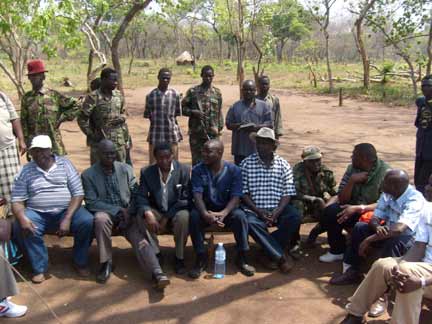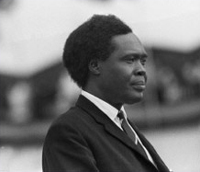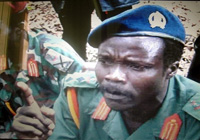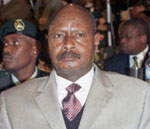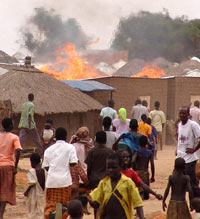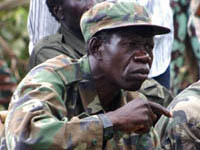The LRA
Where it came from and where it is now
by Billie O'Kadameri
Article published on the 2008-10-08 Latest update 2008-10-09 15:28 TU
July 1985: President Milton Obote overthrown by the Acholi faction of the army, which is dominated by the Acholi and Lango sub-tribes of the Luo ethnic group. The new leaders negotiate a peace deal with the National Resistance Army (NRA) of Yoweri Museveni, which has been conducting a bloody rebellion since the 1980 election.
January 1986: Yoweri Museveni becomes president, after overthrowing the six-month-old military junta.
1987: A cultist rebellion led by former traditional healer and priestess Alice Auma Lakwena begins against Yoweri Museveni’s government, in the Acholi area of mid-northern Uganda. The Holy Spirit Mobile Force (HSMF) grows into a huge movement of over 20,000 whose followers believe Alice Lakwena – the “Messenger” - is possessed by the Christian Holy Spirit that directs her war efforts. They attack government troops, sometimes armed with nothing but raw courage and stones smeared with locally produced traditional vegetable oil from shea nut tree. Lakwena claims these weapons can “turn enemy bullets into water”.
October-December 1987: After a series of suicidal attacks against government forces, Lakwena begins a trek through northern Uganda headed for the east of the country. She claims she will capture the capital, Kampala, and install a government directly appointed by God. She is defeated near Iganga, eastern Uganda, not far from the source of the River Nile, fleeing to neighbouring Kenya with less than 100 fighters. More than 10,000 start the ‘great march’ with her.
September 1987: Joseph Kony, aged 25, starts the Holy Spirit Mobile Force II, a copycat movement, initially dismissed as a repetition of the Lakwena fiasco.
1988-89: With the new government caring little about the new rebel movement and facing another rebellion from the same area initiated by former soldiers of the deposed government, Kony consolidates his support through a combination of forced absorption of remnants of Lakwena’s followers and forced recruitment of members of a rival rebel group. By 1988 his force is estimated to have 10,000 fighters.
1990: Government responds to the threat as Kony advances, using almost the same traditional and non-conventional rituals as Lakwena’s insurgency.
March 1991: Government launches a huge military operation against the rebels, now renamed United Holy Salvation Front (UHSF). The operation shuts off the northern region from national and international scrutiny. Local politicians complain that the operation is high-handed and senior government commander and Junior Defence Minister David Tinyefuza is fired by Museveni.
1992: The rebels, now renamed United Democratic Christian Army (UDCA), is greatly diminished through defections, capture and battlefield deaths. Local politicians mobilise civilians to hunt down rebels using weapons like spears, arrows and machetes. Rebels react by capturing local people, gruesomely maiming them through cutting off their lips, breasts, private parts or their limbs. Rebels also abduct schoolchildren and youth to beef up their ranks.
1993: Joseph Kony renames his group the Lord’s Resistance Army (LRA). Northern Uganda Minister Betty Bigombe opens contact with rebels to explore the possibility of talking them out of fighting.
January 1994: First direct meeting between Kony and a government minister. The Bigombe talks open the prospect of ending the rebellion.
February 1994: The rebels refuse to disarm and demand more time to plan their surrender. Claiming that Sudan was urging the LRA to disrupt the talks, Kampala calls them off.
April 1994: First batch of LRA rebels enter southern Sudan, setting up camp at Gong and Katire, at the apparent invitation of the Sudan government. Sudan accuses Ugandan president Yoweri Museveni of backing the rebel Sudan People’s Liberation Army, which is waging its second war against Khartoum rule.
February 1995: Joseph Kony enters Sudan and establishes new bases in the southern areas of Palutaka, Magwi, Kit, Gong and Katire, bordering northern Uganda. With fresh supplies of weapons given by Sudan, the LRA makes numerous raids into northern Uganda, abducting thousands of children and numerous adults. The war gains international significance as the LRA begins attacking Sudanese rebels at the behest of Khartoum.
April 1995: Rebels cross into Uganda from Sudan and massacre more than 400 civilians in two incidents in the Atyak Township in Gulu. Days later, Uganda breaks off diplomatic relations with Sudan.
October 1995: Uganda, Ethiopia and Eritrea join Southern Sudanese rebels in a massive offensive against the LRA and Khartoum troops in southern Sudan, dislodging rebels from areas near the Uganda border. Rebels set up bases deeper in Sudanese territory closer to regional capital, Juba.
October 1996: The LRA abducts 139 schoolgirls from St Mary’s College, Aboke, in northern Uganda. 100 are released after a daring follow-up and plea by Italian school head, Sister Rachelle Fassera, but 39 are held by rebels and taken to Sudan to be distributed as “wives” to rebel commanders including Joseph Kony. The Aboke girls become the international rallying point against the rebels.1997: Following frequent abductions of civilians by rebels, Uganda government moves most civilians in the affected areas into what it calls “protected camps”, ostensibly to avoid them becoming “unwilling recruits” for the LRA. The camps swell into huge settlements. Government calls in international aid organisations to provide services.
December 1999: Uganda and Sudan renew diplomatic ties in a deal brokered by Jimmy Carter.
2002: United States and Britain designate the LRA as international terrorists. Khartoum says it has cut off support for LRA and Uganda and Sudan sign a military co-operation protocol which allows Ugandan troops to openly attack the LRA inside Sudanese territory, simply legalising what Uganda had been doing for some time without official permission.
July 2002: The first permanent war crimes court established after enough countries ratify the Rome treaty establishing the International Criminal Court.
December 2003: Uganda government refers the LRA to the International Criminal Court for investigation over war crimes, crimes against humanity and violation of international humanitarian law.
2003-2005: Numerous peace efforts by local leaders fail to secure rebel co-operation. Rebels continue operating in small groups in northern Uganda and southern Sudan.
January 2005: Sudan government and the rebel Sudan People’s Liberation Army sign a historic Comprehensive Peace Agreement (CPA), effectively ending two decades of war. Southern Sudan is granted autonomy with a new government under the former rebels. LRA, still operating from bases in the area, see their options diminish further and seek alternatives.
September 2005: First group of LRA rebels cross into western side of River Nile and through Sudan's Western Equatoria province, enter northern Democratic Republic of Congo and settle in the Garamba National Park.
October 2005: The International Criminal Court issues its first-ever arrest warrants for war crimes against five LRA rebel leaders namely General Joseph Kony, Lieutenant-General Vincent Otti, Major-General Raska Lukwiya, Brigadier Okot-Odhiambo and Brigadier Dominic Ongwen.
October 2005: ICC releases details of Kony’s indictment including 33 counts of crimes against humanity, war crimes, sexual enslavement, rape, cruel treatment of civilians and forced enlisting of children.
January 2006: LRA is attacked by UN Peace Keeping Mission in the Democratic Republic of Congo (Monuc) in a botched operation that leaves eight Guatemalan peacekeepers dead and 15 rebels killed.
January-February 2006: LRA makes contact with Southern Sudan government, asking them to mediate talks with the Uganda government.
August 2006: Raska Lukwiya killed by Ugandan army in military operation in Gulu, northern Uganda.
July 2006: Peace talks between Uganda government and LRA begin in Juba. Kony meets elders, religious leaders and politicians from northern Uganda in the Democratic Republic of Congo.
2006: Rebels given an assembly point at Ri-Kwaangba on the border of Sudan and Democratic Republic of Congo, as cessation of hostilities come into effect and the talks get under way.
2007: Difficult phase in the peace process as rebels waver over whether to end the war.October 2007: Following apparent disagreement over the peace talks, Joseph Kony executes his deputy and closest confidante Vincent Otti, who had been more enthusiastic about participation. Lull as mediators figure out the next course of action. Kony reluctantly returns to the talks.
2007: Rebels are accused of going as far as Central African Republic to seek alliances with elements opposed to CAR President François Bozizé and his government.
March 2008: After two years of on-and-off talks, both sides agree on a final peace agreement, with the LRA insisting that the international community should lift the arrest warrants against its leaders before it can demobilise.
April 2008: A planned signing of the final peace agreement flops after rebel leader Kony fails to turn up.
May 2008: Kony sacks and then reinstates his chief negotiator David Matsanga.
June 2008: Kony attacks Sudan People’s Liberation Army unit at Nabanga near Ri-Kwaangba, causing anxiety that the talks will collapse. Speaking exclusively on RFI, in his first interview with an international radio broadcaster, Kony says he wants to resume talks and end the war.
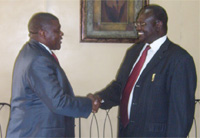
Chief mediator, Southern Sudan Vice-President Riek Machar (R) greets LRA chief negotiator David Matsanga in Juba
(Photo: Billie O'Kadameri)
July-September 2008: Fresh attempts to kick-start the talks show little sign of making progress with hostilities mounting between the rebels and their unwilling partial-hosts, the Sudan People’s Liberation Army.
September 2008: Kony is reported by UN, Southern Sudan authorities and local churches and NGOs as having resumed attacks and abduction of children and other civilians in northern Democratic Republic of Congo and parts of southern Sudan. A final peace agreement, after nearly 20 years of conflict, seems a distant possibility.




